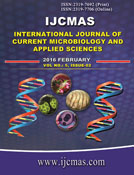


 National Academy of Agricultural Sciences (NAAS)
National Academy of Agricultural Sciences (NAAS)

|
PRINT ISSN : 2319-7692
Online ISSN : 2319-7706 Issues : 12 per year Publisher : Excellent Publishers Email : editorijcmas@gmail.com / submit@ijcmas.com Editor-in-chief: Dr.M.Prakash Index Copernicus ICV 2018: 95.39 NAAS RATING 2020: 5.38 |
This review was aimed to examine the role of nickel in biological system. Nickel plays awell defined role in biological system. Low nickel offers reduce growth this is particularly true of intra-uterine development. Nickel deficiency is also accompanied by histological and biochemical changes and reduced iron resorption and leads to anaemia. When nickel enters the body it is distributed to all organs, but mostly in the kidney, bone, and lungs. Toxicity of nickel arises from elemental nickel and inhaled nickel carbonyl, a carcinogenic gas that results from the reaction of nickel with heated carbon monoxide, from cigarette smoke, car exhaust, and some industrial wastes.Nickel based enzyme system is well known and plays an important role not only in life process but also in the global biological carbon, nitrogen, and oxygen cycles. Nickel is necessary for the biosynthesis of the hydrogenase, carbon monoxide dehydrogenase and found in a number of genera of bacteria. A nickel-tetrapyrrole coenzyme, Cofactor F430, is present in the methyl coenzyme M reductase, which powers methanogenic archaea. One of the carbon monoxide dehydrogenase enzymes CODH consists of an Fe-Ni-S cluster which helps to remove and oxidize 108 tons of CO from earth’s lower atmosphere every year, helping to maintain low CO levels. The plant enzyme urease : an enzyme that assists in the hydrolysis of urea contain nickel. Urease is key to the global nitrogen cycle because it catalyzes hydrolysis of urea, which is a major globally used soil fertilizer.
 |
 |
 |
 |
 |